
Ilex opaca, the American holly, is a species of holly, native to the eastern and south-central United States, from coastal Massachusetts south to central Florida, and west to southeastern Missouri and eastern Texas.

Carissa is a genus of shrubs or small trees native to tropical and subtropical regions of Africa, Australia and Asia. Until recently about 100 species were listed, but most of them have been relegated to the status of synonyms or assigned to other genera, such as Acokanthera.

Ziziphus mauritiana, also known as Indian jujube, Indian plum, Chinese date, Chinese apple, ber and dunks is a tropical fruit tree species belonging to the family Rhamnaceae. It is often confused with the closely related Chinese jujube, but whereas Z. jujuba prefers temperate climates, Z. mauritiana is tropical to subtropical.

Aegle marmelos, commonly known as bael, also Odia quince, golden apple, Japanese bitter orange, stone apple or wood apple, is a species of tree native to the Indian subcontinent and Southeast Asia. It is present in India, Pakistan, Bangladesh, Sri Lanka, and Nepal as a naturalized species. The tree is considered to be sacred by Hindus and Buddhists.
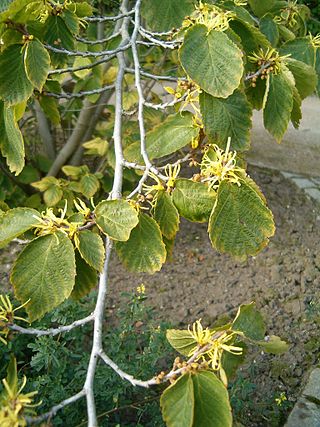
Hamamelis virginiana, known as witch-hazel, common witch-hazel, American witch-hazel and beadwood, is a species of flowering shrub native to eastern North America, from Nova Scotia west to Minnesota, and south to central Florida to eastern Texas.
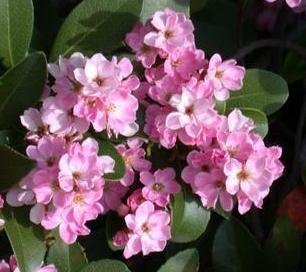
Rhaphiolepis indica, the Indian hawthorn, India hawthorn or Hong Kong hawthorn is an evergreen shrub in the family Rosaceae.
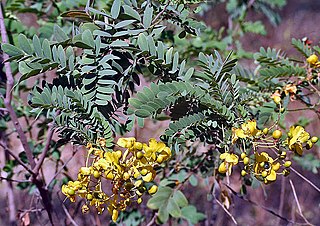
Senna auriculata is a leguminous tree in the subfamily Caesalpinioideae. It is commonly known by its local names matura tea tree, avaram or ranawara, or the English version avaram senna. It is the State flower of Indian state of Telangana. It occurs in the dry regions of India and Sri Lanka. It is common along the sea coast and the dry zone in Sri Lanka.
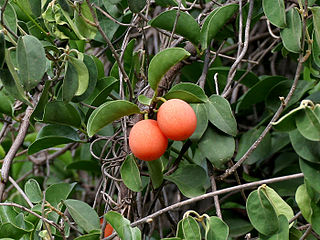
Ximenia americana, commonly known as tallow wood, hog plum, yellow plum, sea lemon, or pi'ut (Chamorro), is bush-forming shrub/small tree; a species from the Ximenia genus in the Olacaceae family. It is mainly found in the tropics, ranging from Africa, India and southeast Asia, to Australia, New Zealand, Pacific Islands, West Indies, Central, North and South America. It is especially common in Africa and South America. It is not domesticated so it is only found occurring in the wild.
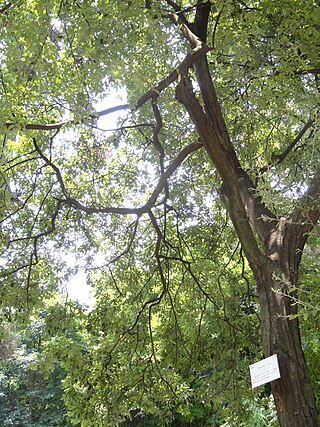
Dichotomanthes is a monotypic genus of flowering plants belonging to the family Rosaceae. The sole species is Dichotomanthes tristaniaecarpa. The flower is perigynous the ovary is superior. The fruit of the plant is a dry achene.

Wrightia tinctoria, Pala indigo plant or dyer's oleander, is a flowering plant species in the genus Wrightia found in India, southeast Asia and Australia. It is found in dry and moist regions in its distribution. Various parts of the plant have been used in traditional medicine, but there is no scientific evidence it is effective or safe for treating any disease.

Bergenia crassifolia is a species of flowering plant of the genus Bergenia in the family Saxifragaceae. Common names for the species include heart-leaved bergenia, heartleaf bergenia, leather bergenia, winter-blooming bergenia, elephant-ears, elephant's ears, Korean elephant-ear, badan, pigsqueak, Siberian tea, and Mongolian tea.
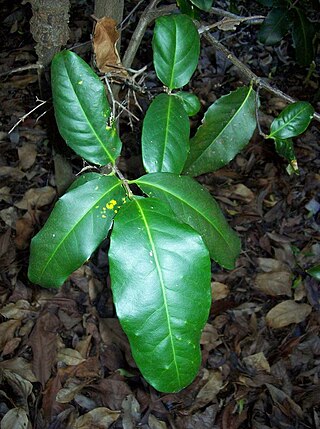
Corynocarpus rupestris, commonly known as the Glenugie karaka, is a rainforest tree found in eastern Australia. It is a rare plant with a ROTAP rating of 2VC-t. There are two sub-species; arborescens is a small hairless shrub or tree up to 13 metres tall with a stem diameter up to 40 cm (16 in), and sub-species rupestris grows only to 6 metres, with a stem diameter up to 17 cm (6.7 in).

Hakea tephrosperma commonly known as hooked needlewood, is a shrub or small tree species in the family Proteaceae. It has cream flowers, needle-shaped leaves and is one of the taller species adaptable for dry to temperate locations.

Ximenia caffra, the sourplum, is a small tree or small shrub that is thinly branched. It is part of the Olacaceae family which is native throughout tropical regions. In particular, the sourplum is native to regions in South East Africa, mainly Botswana, Kenya, Malawi, Mozambique, South Africa, Tanzania, Uganda, Zambia, and Zimbabwe. The sourplum tree produces several fruits on an annual basis. These are generally sour with a dry aftertaste, and they contain significant amounts of potassium. The tree itself is fairly hardy, with frost resistance and drought tolerance. The tree, fruit, seed, leaves, and roots are all used for human consumption, medicinally, or for fuel. The trees themselves can also be used as natural land division barriers.

Maesa lanceolata, the false assegai, is a tree species that is widespread in the Afrotropics, including Madagascar. It occurs from the southern Arabian Peninsula, southwards to the Eastern Cape, South Africa. It grows on stream verges, river banks and forest verges, where it is often a pioneer plant.

Cadaba aphylla ("Swartstorm") is one of the many species in the genus Cadaba. It is indigenous to southern Africa.
Ludia mauritiana is a species of evergreen tree in the family Salicaceae. It is native to southeastern Africa and Madagascar. It was first described by the German botanist Johann Friedrich Gmelin, the type locality being Mauritius.
Drypetes gerrardii is a species of small tree or large shrub in the family Putranjivaceae. Common names include forest ironplum, bastard white ironwood, and forest ironwood. It is native to tropical and subtropical central and eastern Africa. It was first described in 1920 by the English botanist John Hutchinson, who named it after the English botanist William Tyrer Gerrard who collected plants and seeds in southern Africa in the 1860s.
Thilachium africanum is a shrub or small tree within the family Capparaceae. It is found in Eastern and Southern Africa, from Kenya to Northeastern parts of South Africa and also in Madagascar

Ficus asperifolia is a species of shrub or small sized gynodioecious fig tree belonging to the family Moraceae. It grows up to 6 m high and often has climbing branches.
















